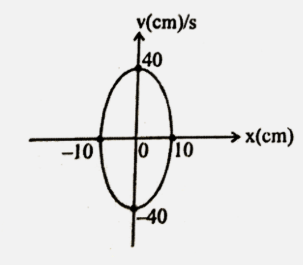The maximum velocity of a particle, excuting simple harmonic motion with an amplitude 7mm, is 4.4m/s The period of oscillation is.
100s
0.01s
10s
0.1s
The correct Answer is:B
To find the period of oscillation for a particle executing simple harmonic motion (SHM), we can use the relationship between maximum velocity, amplitude, and angular frequency. Here’s a step-by-step solution:
Step 1: Write down the formula for maximum velocity in SHM
The maximum velocity vmax in simple harmonic motion is given by the formula:
vmax=Aω
where:
- A is the amplitude,
- ω is the angular frequency.
Step 2: Convert the amplitude to meters
The amplitude is given as 7mm. We need to convert this to meters:
A=7mm=7×10−3m
Step 3: Substitute the values into the formula
We know that the maximum velocity vmax is 4.4m/s. Substituting the values we have:
4.4=(7×10−3)ω
Step 4: Solve for angular frequency ω
Rearranging the equation to solve for ω:
ω=4.47×10−3
Calculating this gives:
ω≈4.40.007≈628.57rad/s
Step 5: Relate angular frequency to the period
The angular frequency ω is related to the period T by the formula:
ω=2πT
Rearranging this to solve for T:
T=2πω
Step 6: Substitute ω to find the period T
Substituting the value of ω:
T=2π628.57
Calculating this gives:
T≈6.2832628.57≈0.01s
Final Answer
The period of oscillation T is approximately 0.01s.
---
The maximum velocity vmax in simple harmonic motion is given by the formula:
vmax=Aω
where:
- A is the amplitude,
- ω is the angular frequency.
The amplitude is given as 7mm. We need to convert this to meters:
A=7mm=7×10−3m
We know that the maximum velocity vmax is 4.4m/s. Substituting the values we have:
4.4=(7×10−3)ω
Rearranging the equation to solve for ω:
ω=4.47×10−3
Calculating this gives:
ω≈4.40.007≈628.57rad/s
The angular frequency ω is related to the period T by the formula:
ω=2πT
Rearranging this to solve for T:
T=2πω
Substituting the value of ω:
T=2π628.57
Calculating this gives:
T≈6.2832628.57≈0.01s
The period of oscillation T is approximately 0.01s.
Topper's Solved these Questions
- BOOK - RESONANCE ENGLISHCHAPTER - SIMPLE HARMONIC MOTION EXERCISE - Advanced Level Problems13videos
SIMPLE HARMONIC MOTION
- BOOK - RESONANCE ENGLISHCHAPTER - SIMPLE HARMONIC MOTION EXERCISE - Exercise- 3, PART - I20videos
SIMPLE HARMONIC MOTION
- BOOK - RESONANCE ENGLISHCHAPTER - SEMICONDUCTORSEXERCISE - Exercise 388videos
SEMICONDUCTORS
- BOOK - RESONANCE ENGLISHCHAPTER - TEST PAPERSEXERCISE - PHYSICS784videos
TEST PAPERS
Similar Questions
Knowledge Check
- Question 1 - Select One
The maximum velocity of a particle executing simple harmonic motion is v. If the amplitude is doubled and the time period of oscillation decreased to 1/3 of its original value the maximum velocity becomes
A18vB12vC6vD3v - Question 2 - Select One
The displacement of a particle executing simple harmonic motion is given by y=4sin(2t+ϕ). The period of oscillation is
A2/πBπ/2CπD2π - Question 3 - Select One
A particle executing simple harmonic motion with an amplitude A. The distance travelled by the particle in one time period is
AzeroBAC2AD4A
A particle executing simple harmonic motion of amplitude 5 cm has maximum speed of 31.4 cm / s . The frequency of its oscillation is
View SolutionIn simple harmonic motion,the particle is
View SolutionThe displacement of a particle in simple harmonic motion in one time period is
View SolutionThe plot of velocity (v) versus displacement (x) of a particle executing simple harmonic motion is shown in figure. The time period of oscillation of particle is :-
 View Solution
View SolutionThe distance moved by a particle in simple harmonic motion in one time period is
View Solution
